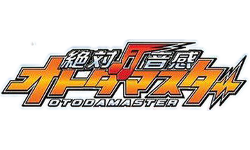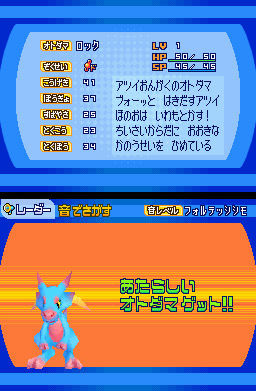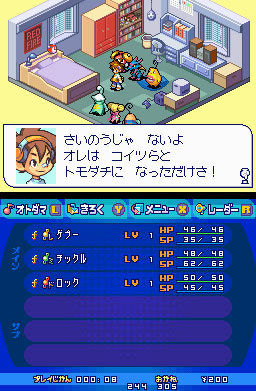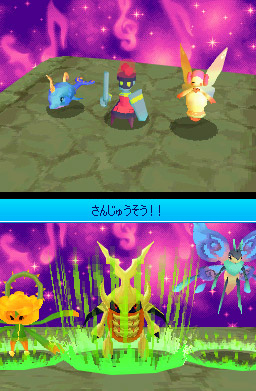|
|

|
PLATFORM
|
DS
|
BATTLE SYSTEM
|

|
INTERACTION
|

|
ORIGINALITY
|

|
STORY
|

|
MUSIC & SOUND
|

|
VISUALS
|

|
CHALLENGE
|
Moderate
|
LANGUAGE BARRIER
|
Moderate
|
COMPLETION TIME
|
20-40 Hours
|
|
OVERALL

|
+ Knows its target demographic
+ Masters its core schtick quite well
+ Otodama Radar is a cool idea
- Gatekeeper mooks get kind of ridiculous
- Final boss is very overpowered
|
Click here for scoring definitions
|
|
|
Many years ago, when I first started teaching here in Hi-no-Kuni, one of my sixth grade students was really into this one game: Zettai Onkan OtodaMaster. It was about the only thing I could get him to talk about freely, as he was a shy and taciturn young man, but it was obvious that he really enjoyed this game. So when I saw it last winter during a big sale at my local GeoGeo, I just had to grab it. The fact that I managed to get it at fifty percent off of 80 yen (i.e. ridiculously cheap) was a bonus. It's certainly worth a good deal more than I paid for it, though that wouldn't take much.
OtodaMaster is one of the many Pokémon clones to pop up on Nintendo's handhelds over the years, though like all such examples it strives hard to find its own quirks and qualities to make it stand out from the crowd. So what we get is a game based heavily on sound. Wielding an army of sound-based elementals called Otodama, a kid named Noise has invaded Kodama Island, placing large sections of it under his control and erecting strange tuning forks in strategic locations. Opposing him is Otoya, a local kid who's obsessed with rock'n'roll. After the initial takeover of Otoya's elementary school, he discovers that he too can direct the mysterious Otodama via a comical toy megaphone. So, with the sounds of a burp, an alarm clock, and his favorite rock CD at his command, he sets out to take back Kodama Island from Noise's Sextet.
The game's story is divided into seven unofficial chapters, and plays out much as one would expect of a shonen-styled game targeted for elementary schoolers. Most regions are controlled by one of Noise's Sextet, with the story playing out episodically around the enemy of the moment. In one region, a cymbal-crashing wild child is fighting deforestation even as he furthers Noise's plans. In another, an apparent Martian holes up in a video game arcade full of UFO catcher games. There's a ninja base in a department store, and a silly tribute to The Phantom of the Opera at one point. And then there's the game's fifth chapter, which is essentially one long, extended fart joke. There's also plenty of filler and gatekeepers, enemy mooks who exist only to provide an obstruction to progress. Many of these generic mooks have stolen the power of a highly specific sound, like a sliding door or the ding of an elevator, and use their influence to prevent Otoya from opening doors, riding lifts, or walking up the stairs. The majority of these are pretty inane, like the guy who stole the sounds of all the hairdryers in town, just so he could get a good nap in, and the circuitous routes the game takes to make this percussive pilfering relevant are often hilarious in their cheesiness.
 I am not your friend...
I am not your friend...
|
|
The game's monsters, the Otodama, are spirits representative of the many strange onomatopoeia present in the Japanese language, as well as any other noise imaginable. Battles are generally up to three-on-three for random encounters, and enemy OtodaMasters may have a full back bench as well. Most Otodama follow a four-step circle of strengths and weaknesses, following the Fire-Earth-Wind-Water model — or as they're classed in this game, Do-Re-Mi-Fa, with So as the supreme non-elemental alignment of many enemies in the final level. The battle music cycles through different color-themed tunes, and Otodama of the same color/note will get a boost while the song is in effect. Likewise, all of an Otodama's skills align with one of these notes, which is where the strategy of the battle system comes into play. By having all three monsters on the front line use skills of the same note, they achieve "three-part harmony", effectively an attack combo that increases skill power by fifty percent and makes all three attacks happen in quick succession in spite of the usual turn order.
More than many monster-collecting games, OtodaMaster gives the player a lot of leeway in how the monsters learn skills or evolve. Evolution is usually enabled past certain levels of experience, or when certain conditions are met, but it has to be triggered from within the game's status menu. Monster skills are unlocked as experience is gained, but it's still up to the player to activate them using "sound bytes" gathered after battle.
The game's capture mechanic does not involve trapping monsters directly in battle. Instead, the player must use the game's Otodama Radar, which works directly through the DS microphone. The game is coded to recognize patterns of sound waves as being linked to specific monsters, and encourages kids to scan the surrounding area for any noise that might provoke a reaction. On its first setting, the radar reacts only to volume and pitch, and sounds like clapping, stomping feet, and banging pots will summon up beasties. The second setting lets the radar pick up monsters from specific words and phrases in Japanese: mostly standard vocabulary, tongue-twisters, and the names of a few famous composers. The third and final setting picks up melodies, specifically as played from a recorder such as the sort owned by any schoolchild in Japan as part of their general education. The melody setting really does require a recorder, by the way. No other method of playing melodies seems to work.
 I'm not your only friend...
I'm not your only friend...
|
|
The Otodama are a curious band of monsters, numbering one hundred thirty within the regular course of the game, plus four gotten from real-world promotional events. The hero, young rock'n'roll enthusiast that he is, starts off with a dragon summoned from his favorite band's number one album, the noise of his alarm clock, and a living burp. Those three are unique, but have palette-swapped variants appearing as enemies. In fact, a significant fraction of the Otodama are palette swaps (often but not always within the same monster lineage), making this game's bestiary a little disappointing compared to some monster-collecting titles. Swaps aside, the base designs are zany and well-made for both the 3D battle models and the occasional 2D sprite to show up in the main body of the game. Outside of the six main bad guys, there are three general models of mook with at least seven color variations, and since they represent ninety-nine percent of the enemy ranks, the player will be very tired of them by the end.
The scenery, on the other hand, is about as varied and colorful as one can get. Once Otoya's elementary school is liberated from the invading forces, he gets a whirlwind tour of Kodama Island, from the forests of Seseragi to the factories and game centers of Kikai, the vaguely Osaka-like Don-Don-Dori, and the elegant opera house of Sonata Town. And of course there's Buketsu Island, the fifth chapter's overly elaborate series of fart jokes made real.
All of this is accompanied by a soundtrack worthy of a game focused on the powers of sound. The many town themes are lively and bouncy, while the rotating series of combat tunes actually play into one of the battle mechanics. Sound effects litter the landscape, just waiting to be discovered, and any available piano can be played for fun. All of this music makes the final level, the Halls of Hush (personal localization) powerful and dramatic in its total absence of sound. It's incredibly ominous, after all of the music the game throws at the player prior to this. Then, upon arrival at the big castle at the heart of the level, the silence gets so oppressive that the characters can't hear themselves speak anymore, and can't call for their monster allies to fight. All seems lost, but then all of Otoya's friends from throughout the game arrive, with instruments, and proceed to hold an impromptu rock'n'roll jam session to force some life back into the area and restore the BGM.
 But I'm your little glowing friend...
But I'm your little glowing friend...
|
|
That there is some solid use of the auditory component for storytelling, I must say. I would apologize for the spoilers, but it's too awesome not to be shared. If you do pick this game up in the future, rest assured that there's a decent payoff by the end, if one is into shonen style plotting.
OtodaMaster does provide some annoyances beyond the need for a recorder. There are a few points where the difficulty seems to spike for no good reason, often in conjunction with marathon battle sessions. The worst of these is the final boss itself, which is a full twenty levels higher than anything else in the dungeon — including the penultimate boss that turns into it upon defeat. On the other hand, this last one is somewhat justified by the fact that it's a single target facing Otoya's full bench of six monsters, but it's still an amazingly tough nut to crack. There are times where the player will just have to grind for a bit, but at least there are healing spots spaced regularly throughout levels, and an auto-pilot button for when the small fry get too weak to worry about.
Despite some negatives, in major and minor keys, Zettai Onkan OtodaMaster is a solid little title for something that came out in 2007. It's unfortunate that it had to go the way of all other monster-collecting titles that are not Pokémon, eventually getting consigned to the extreme bargain bins of video game history. Of course, that makes things more fortunate for me, considering the price I actually paid for it last winter. I'd consider it a bargain at ten, or even twenty times that price, though.
Review Archives
|









